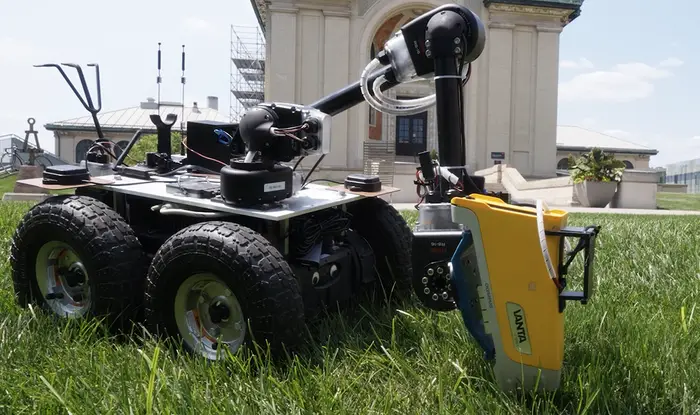When researchers need to collect data about a worksite’s soil quality, they can run into several problems. Using excavators to access sites can be challenging, expensive, and may limit the ability to collect samples. Once an excavator does return a scoop of soil, scientists must still collect soil samples by hand for shipping and analysis at an off-site commercial lab. In short, their work is often dirty, dangerous and expensive.

But what if they could run a robot the size of a small dog along the same route? It navigates to the site alone as its wheels help it pass over stones and other obstacles. Its sensor can analyze a sample in real time, allowing its artificial intelligence-enhanced algorithms to determine where the most ideal location is to take the next sample, so it only takes as many as it needs. When it is done, it navigates back to the researchers. This time, it searched out and measured the presence of chloride in the soil to test for salt concentrations, though in the future, it will be able to sense other substances.
This robot is part of a multiyear project by an interdisciplinary team of Carnegie Mellon University researchers, led by Greg Lowry(opens in new window) and Aaron Johnson(opens in new window)(opens in new window) and in collaboration with Chevron, seeking to understand how robotics and AI can help engineers address environmental challenges.
Increasingly engineers have been applying robotics to agricultural research and to monitor different environments, such as underwater and aerial imagery. However, Johnson, associate professor of mechanical engineering(opens in new window), said that this team’s focus, which specifically applies robotics to monitoring affected soils, is unique.
“This is often where the exciting research happens, in this intersection of two fields,” he said.
This robot and research published in the Journal of Environmental Management(opens in new window), stand as a proof-of-concept for the project as a whole to show that these fields really are complementary.
[embedded content]
The authors detail a method of designing robots so that other teams can follow in their footsteps (or wheel-tracks) to meet their own objectives. Johnson and Lowry suggest using four design components to guide decisions: sensing, which quantifies a substance in a sample; sampling, which extracts and processes samples; mobility, which moves the robot around the site; and autonomy, which determines relevant locations and how best to navigate to them.
“Other parts of the project include looking at the exploration algorithm to improve the autonomy, trying out different sensors, different locations and applying the same strategies to different problems,” Johnson said.
The project has taken several years of careful research, as well as dealing with limitations within a worldwide pandemic, to get to this stage. Therefore, it has involved a number of personnel with a wide range of experience, from undergraduates to postdoctoral researchers. They have also partnered with HEBI Robotics(opens in new window), which has developed a “ruggedized” version of the lab-made robot that was featured in the paper.
“Carnegie Mellon University is a private research university in Pittsburgh, Pennsylvania. The institution was originally established in 1900 by Andrew Carnegie as the Carnegie Technical School. In 1912, it became the Carnegie Institute of Technology and began granting four-year degrees.”
Please visit the firm link to site


